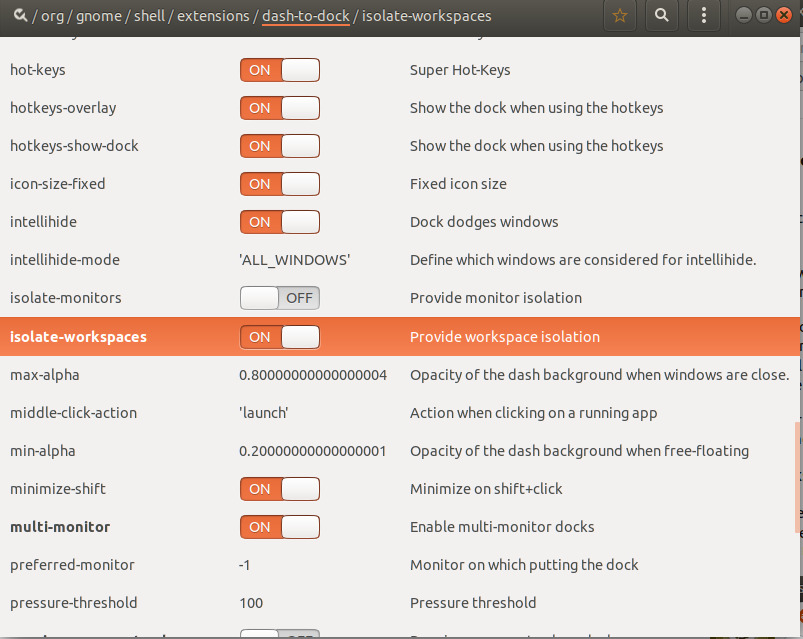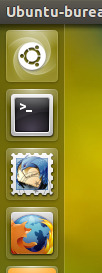问题描述
是否可以在启动器中打开当前工作区的应用程序,而不是来自其他工作区的应用程序?
最佳方案
对于 Ubuntu 17.10 及更高版本(使用 GNOME)附带的 Ubuntu Dock
好吧,其他答案已经很老了,所以我认为值得添加 up-to-date 答案。现在就可以这样做而且不太难(使用 Ubuntu 17.10 并且它具有 Gnome)。
只需使用 dconf-editor:
sudo apt install dconf-editor
导航到组织 >侏儒>壳>扩展 > dash-to-dock 并检查 isolate-workspaces

次佳方案
如何使应用程序在(其他)工作空间上无法追踪
使用 xdotool 的 windowunmap ,可以完全隐藏窗口。该窗口及其应用程序不再出现在启动器图标中,甚至不再在 wmctrl 的输出中列出。
从理论上讲,这可以连接到在 this 和 this 答案中使用的 “workspace-engine”。那将是最优雅的解决方案。
但是,仅在其他工作空间上隐藏窗口并在当前工作空间上自动提升窗口的过程对于在正在进行的后台脚本中使用(目前)要求太高,而且也不太可能“感冒”。由于一旦出现错误,窗口就会永远丢失,因此我决定不将该过程作为自动(后台)过程提供。
这个答案是否仍然对您有用取决于情况,以及您想要隐藏在其他工作区上运行的应用程序图标的原因;决定权在你。
解决方案;它是什么以及它在实践中是如何工作的
-
一个脚本,在快捷键下可用,似乎使当前工作区(以及应用程序)上的所有窗口完全消失。这意味着 Unity 启动器中的应用程序图标显示该应用程序没有任何活动: 三个正在运行的应用程序: 按下快捷键后:


-
再次按下快捷键组合,窗口及其应用程序将 re-appear。
-
由于组合键只会隐藏当前工作区中的窗口和应用程序,因此您可以随后切换到另一个工作区,而不会显示当前工作区中(隐藏)的内容。
-
也(仅)在当前工作空间上完成取消隐藏,因此简而言之,隐藏和取消隐藏的过程是完全独立于每个工作空间进行的。
剧本
#!/usr/bin/env python3
import subprocess
import os
import time
datadir = os.environ["HOME"]+"/.config/maptoggle"
if not os.path.exists(datadir):
os.makedirs(datadir)
workspace_data = datadir+"/wspacedata_"
def get_wlist(res):
res = get_res()
try:
wlist = [l.split() for l in subprocess.check_output(["wmctrl", "-lG"]).decode("utf-8").splitlines()]
return [w for w in wlist if all([
0 < int(w[2]) < res[0],
0 < int(w[3]) < res[1],
"_NET_WM_WINDOW_TYPE_NORMAL" in subprocess.check_output(["xprop", "-id", w[0]]).decode("utf-8"),
])]
except subprocess.CalledProcessError:
pass
def get_res():
# get resolution
xr = subprocess.check_output(["xrandr"]).decode("utf-8").split()
pos = xr.index("current")
return [int(xr[pos+1]), int(xr[pos+3].replace(",", "") )]
def current(res):
# get the current viewport
vp_data = subprocess.check_output(
["wmctrl", "-d"]
).decode("utf-8").split()
dt = [int(n) for n in vp_data[3].split("x")]
cols = int(dt[0]/res[0])
curr_vpdata = [int(n) for n in vp_data[5].split(",")]
curr_col = int(curr_vpdata[0]/res[0])+1
curr_row = int(curr_vpdata[1]/res[1])
return str(curr_col+curr_row*cols)
res = get_res()
try:
f = workspace_data+current(res)
wlist = eval(open(f).read().strip())
for w in wlist:
subprocess.Popen(["xdotool", "windowmap", w[0]])
os.remove(f)
except FileNotFoundError:
current_windows = get_wlist(res)
open(f, "wt").write(str(current_windows))
for w in current_windows:
subprocess.Popen(["xdotool", "windowunmap", w[0]])
如何使用
-
该脚本需要
wmctrl和xdotool:sudo apt-get install wmctrl xdotool -
将脚本复制到一个空文件中,保存为
toggle_visibility.py -
测试-运行脚本:在终端窗口中,运行命令:
python3 /path/to/toggle_visibility.py现在打开一个新的终端窗口(因为第一个似乎从地球表面消失了)并再次运行相同的命令。所有窗口应为 re-appear。
注意:确保您在测试时没有打开 “valuable” 窗口
-
如果一切正常,请将命令添加到快捷键组合中:选择:系统设置 > “Keyboard” > “Shortcuts” > “Custom Shortcuts”。单击 “+” 并添加命令:
python3 /path/to/toggle_visibility.py
Explanation
如前所述,该脚本使用 xdotool 的 windowunmap 来(完全)隐藏窗口及其所属的应用程序。剧本:
-
读取当前工作区是什么
-
读取当前工作区中存在的窗口(仅)
-
将窗口列表写入以当前工作区命名的文件
-
隐藏窗户
在下一次运行时,脚本:
-
检查当前工作空间对应的文件是否存在
-
如果是,则读取窗口列表并取消隐藏窗口。
从而切换当前工作空间上的窗口和应用程序的可见性。
第三种方案
不幸的是,这是不可能的。
Unity 总是显示来自任何地方的所有应用程序,并且没有办法改变这一点。有一个错误报告 – https://bugs.launchpad.net/ayatana-design/+bug/683170 但似乎开发人员不会做任何事情。可能如果您在页面顶部标记此错误会影响您,它将帮助开发人员了解此类选项的重要性。
